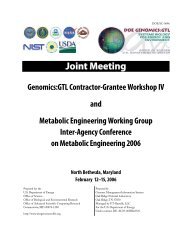Joint Meeting - Genomics - U.S. Department of Energy
Joint Meeting - Genomics - U.S. Department of Energy
Joint Meeting - Genomics - U.S. Department of Energy
Create successful ePaper yourself
Turn your PDF publications into a flip-book with our unique Google optimized e-Paper software.
22<br />
Systems Biology for DOE <strong>Energy</strong> and Environmental Missions<br />
Metabolic engineering <strong>of</strong> Synechocystis sp. PCC 6803<br />
strains with the capability <strong>of</strong> consistent, high-yield,<br />
biosolar hydrogen (H 2 ) production requires continued<br />
development <strong>of</strong> comprehensive mathematical models<br />
describing the metabolism underlying H 2 production and<br />
linking genomic, proteomic, and metabolomic information.<br />
Such models help to organize disparate hierarchical<br />
information, discover new strategies, and understand the<br />
essential qualitative features <strong>of</strong> components and interactions<br />
in a complex system 1 . Metabolic flux analysis is an<br />
analytical approach used to estimate the fluxes through<br />
a biochemical reaction network operating at steady state<br />
based on measured inflows and outflows. Analysis <strong>of</strong><br />
both over- and underdetermined networks is possible, the<br />
latter with linear programming. Here we use metabolic<br />
flux analysis to examine the effect <strong>of</strong> different network<br />
parameters and constraints on photoautotrophic H 2<br />
production by wild type (WT) Synechocystis sp. PCC<br />
6803 and by a high H 2 -producing mutant (M55) with<br />
impaired Type I NADH-dehydrogenase (NDH-1)<br />
function. Two different networks are used with both<br />
WT and M55 mutant strains under chemostat growth:<br />
1) an overdetermined network with 24 metabolites and<br />
20 constraints, requiring at least 4 measurements <strong>of</strong> fermentation<br />
parameters for solution; and 2) an underdetermined<br />
network with increased detail for gene knockout<br />
simulations, requiring constraints-based approaches for<br />
solution1. The inflows and outflows measured for both<br />
networks are H 2 , O 2 , CO 2 , glucose, glycogen, ammonium,<br />
and biomass production/consumption. The behavior <strong>of</strong><br />
both model networks is consistent with WT and M55<br />
mutant phenotypes, thus validating the general approach.<br />
The models are then used to provide insights into the<br />
possible effects <strong>of</strong> different mutant phenotypes on H 2<br />
production.<br />
References<br />
1. Bailey, J.E. (1998) Mathematical modeling and<br />
analysis in biochemical engineering: Past accomplishments<br />
and future opportunities. Biotechnol.<br />
Prog. 14:8-20.<br />
2. Price, N.D., Reed, J.L. and Palsson, B. Ø. (2004)<br />
Genome-Scale Models <strong>of</strong> Microbial cells: Evaluating<br />
the Consequences <strong>of</strong> Constraints. Nature<br />
Review|Microbiology 2:888-897.<br />
* Presenting author<br />
26<br />
Optimization <strong>of</strong> Media Nutrient<br />
Composition for Increased<br />
Phot<strong>of</strong>ermentative Hydrogen<br />
Production by Synechocystis sp. PCC<br />
6803<br />
Elizabeth H. Burrows,* Frank W.R. Chaplen, and<br />
Roger L. Ely (ely@engr.orst.edu)<br />
<strong>Department</strong> <strong>of</strong> Biological and Ecological Engineering,<br />
Oregon State University, Corvallis, Oregon<br />
Project Goals: See goals for abstract 23.<br />
By optimizing concentrations <strong>of</strong> key components in<br />
nutrient media, we achieved over 60-fold greater phot<strong>of</strong>ermentative<br />
hydrogen (H ) production by Synechocystis<br />
2<br />
sp. PCC 6803 than was achieved by analogous, sulfurdeprived<br />
cultures, which produce more H than cultures<br />
2<br />
grown on complete media. We used response surface<br />
methodology to determine optimum conditions and<br />
found that, instead <strong>of</strong> completely starving cells <strong>of</strong> sulfur<br />
or nitrogen, the highest H production occurred with low<br />
2<br />
concentrations <strong>of</strong> S and N. H pr<strong>of</strong>iling experiments pro-<br />
2<br />
+ - 2- 3-<br />
vided initial screening <strong>of</strong> NH , HCO3 , SO4 , and PO4<br />
4<br />
concentrations and identified the significant variables for<br />
+ 2- H production to be NH , SO4 , and the interactions <strong>of</strong><br />
2 4<br />
+ 2- - both NH and SO4 with HCO3 . A central composite<br />
4<br />
design was implemented and subsequent response surface<br />
analysis <strong>of</strong> the data resulted in a saddle point. Ridge<br />
analysis was then conducted to identify high points<br />
within the region <strong>of</strong> interest, and those concentrations<br />
were tested and compared with sulfur-deprived cells. Our<br />
results indicate that optimized amounts <strong>of</strong> nitrogen and<br />
sulfur in the nutrient media are superior to total deprivation<br />
<strong>of</strong> these nutrients for H production.<br />
2<br />
27<br />
Performance <strong>of</strong> REHX, A<br />
Synechocystis sp. PCC 6803 Mutant<br />
with an Oxygen-Tolerant hoxH<br />
Subunit from Ralstonia eutropha<br />
Hatem Mohamed,* 1 Paul S. Schrader, 2,3 Elizabeth H.<br />
Burrows, 1 and Roger L. Ely 1,2 (ely@engr.orst.edu)<br />
GTL<br />
GTL<br />
1 <strong>Department</strong> <strong>of</strong> Biological and Ecological Engineering,<br />
Oregon State University, Corvallis, Oregon;<br />
2 <strong>Department</strong> <strong>of</strong> Chemical Engineering, Yale University,





